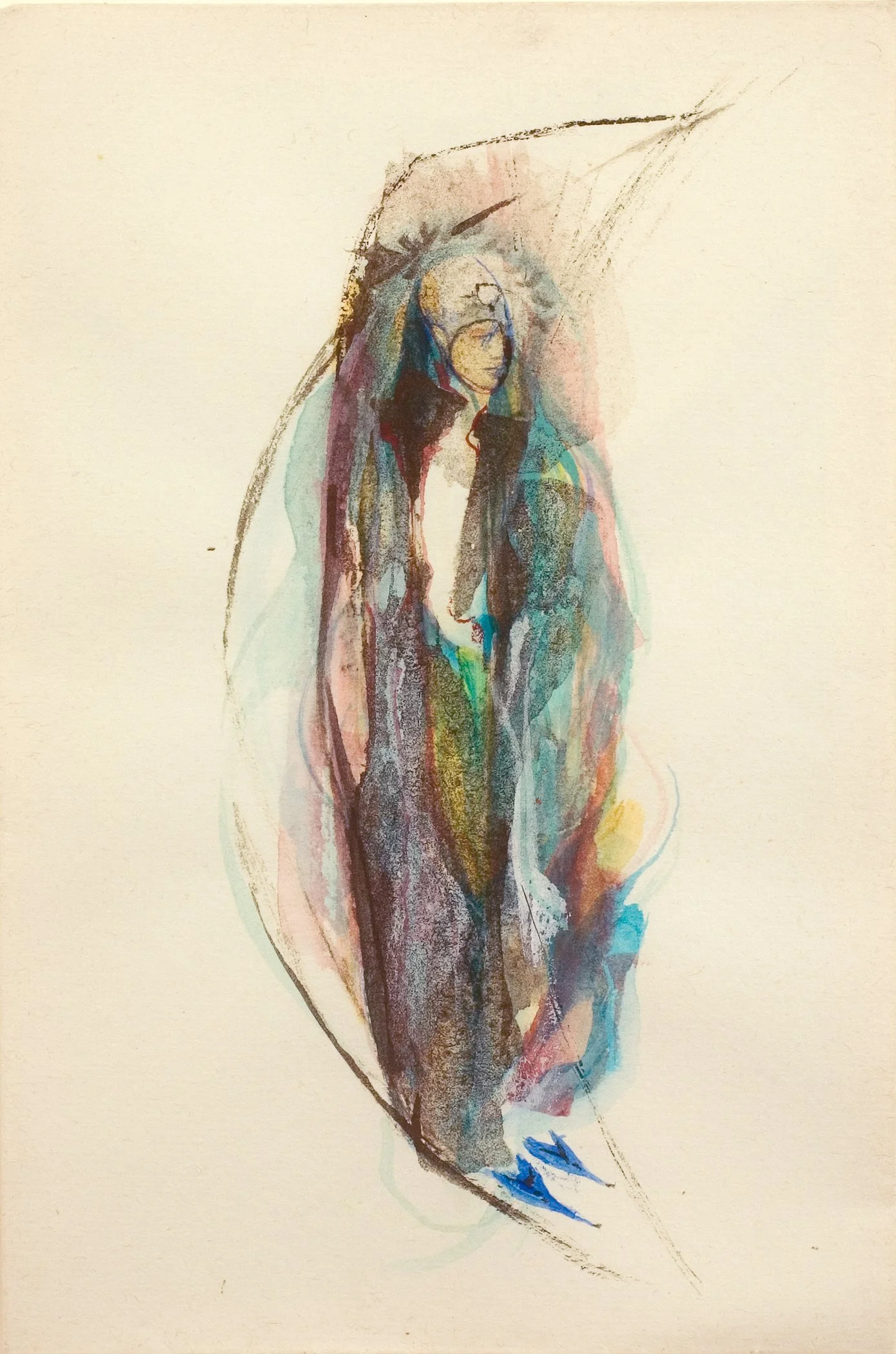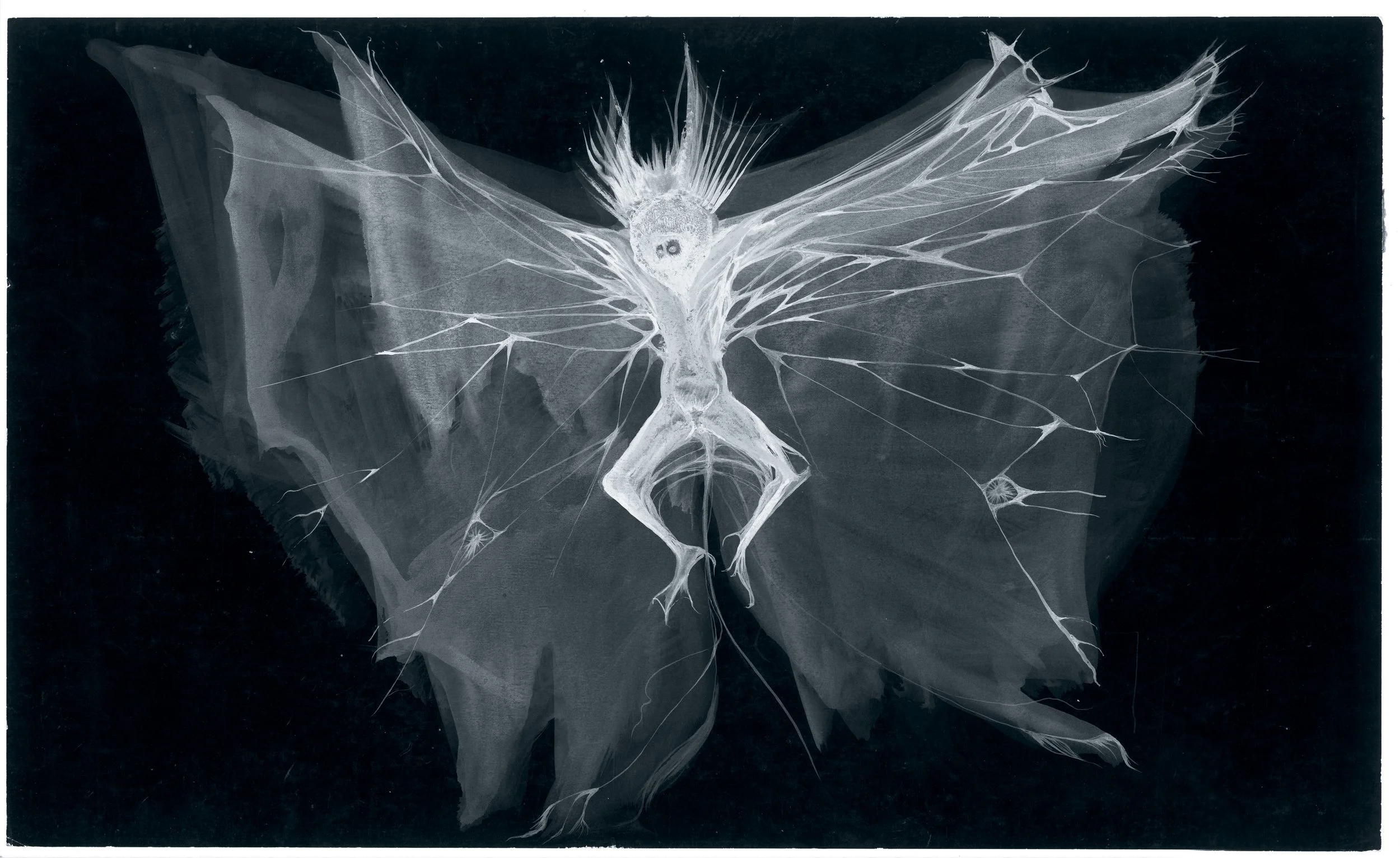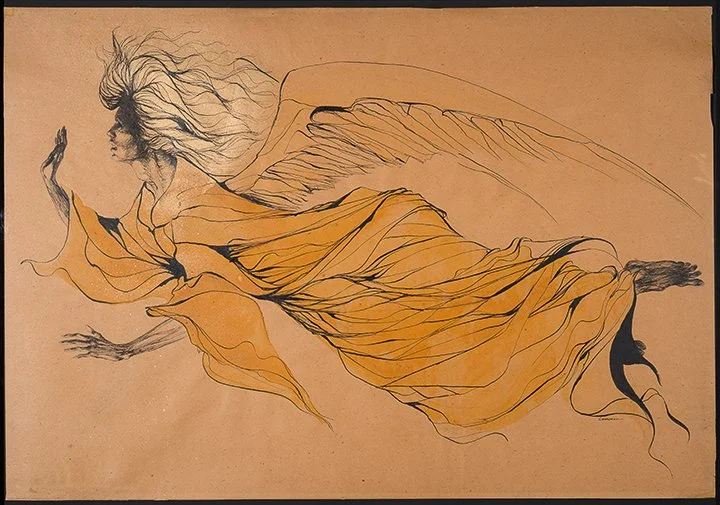the Orphic
Marjorie Cameron
American Artist
Actress
Poet
B/D
1922-1995
Described as an avant-garde, unrestrained talent, many of Cameron’s paintings parallel the enduring themes of her life… longing for transcendence, deciphering the mythological, and seeking communion with the supernatural, concepts afar from a rational mind. Often referred to as a maverick, she was one of the most influential artists in the Los Angeles counterculture movement. Her fanaticism for the occult characterized in her work evoked a shadowy mystery, curious visions, and often erratic forms of her imagination. Since her death in 1995, her influence has emerged as one of the most powerful and significant women artists of the 20 th century.
Cameron’s reemergence is largely due to the efforts of the Cameron Parsons Foundation’s executive director, Scott Hobbs, and the Nicole Klagsbrun Gallery. Mr. Hobbs first met Cameron in 1984 through his yoga friends Cynthis McAdams and Victoria Ballesteros. Upon meeting her, I had no idea who she was, but over time, my appreciation of her art culminated particularly when I attended the exhibit, The Pearl of Reprisal (1989) at the Los Angeles Municipal Art Gallery. The show included watercolor, ink, and casein drawings from Cameron’s series Anatomy of Madness (1956) and Pluto Transiting the Twelfth House (1978-1980). She also read her prose,” comments Mr. Hobbs. Mr. Hobbs and Cameron became friends, so much so that shortly after her death, Mr. Hobbs was contacted by Lorraine Wilde, who was writing the catalog for the Whitney Museum’s exhibition, The Beat Culture (1950-1965). The exhibition paid tribute to Beat Generation artists, many who were contemporaries of Cameron. The Beat show’s curator Lisa Philips asked Ms. Wilde if perchance, she had any contacts to the mystic artist named Cameron who recently passed away. Ms. Philips was searching for any pieces of Cameron’s work to include in the exhibit. Ms. Wilde who frequented Mr. Hobbs’ yoga class heard him talk about Cameron as his friend and artist, she successively introduced Mr. Hobbs to Ms. Philips and synchronicity ensued. As a result, one of Cameron’s most noted pieces of work Peyote Vision was lent to the Whitney along with some pieces of prose and ephemera arranged by Mr. Hobbs to be shown in the Beat exhibit.
17-year-old Marjorie Cameron working on a portrait of a classmate.
“refined draftsmanship, formal command, and fantastic imaginative powers. Her sensitive drawings and paintings delineate a magical realm, of metamorphosis and protean transformation. Featuring symbolic creatures in imaginary landscapes, her delicately articulated artworks rival those of fellow surrealists such as Leonora Carrington, Remedios Varo, Ithell Colquhoun, and Leonor Fini. They also seem fascinatingly prescient of fantastical works by contemporary artists such as Kiki Smith, Amy Cutler, Karen Kilimmck, and Hernan Bas.”
— Michael Duncan, independent curator
Born in Belle Plain, Iowa she was challenged to fit into her church-going family and was deemed defiant and rebellious by her pursuits of ethereal phenomena, magic, and walking outside under moonlight. Consequently, after graduating from high school, she enlisted as a women’s volunteer in the Navy during WWII where she was poised to draw maps and work in photography.
When honorably discharged from the Navy in 1946 she moved to be with her family in Pasadena, CA, where she met her famous husband, rocket scientist and chemist Jack Parsons. Taken by her seductive looks and red hair, Jack believed she was his Scarlet Woman, an incarnate of the sex magick rituals he had been practicing. Practices based upon the religious movement Thelema, founded by the famed British occultist Alister Crowley. Parsons’ occult practices over time shaped Cameron as he continually attempted to indoctrinate her into the esoteric arts. They married within a year after their meeting, but Cameron, skeptical of Jack’s mysticism, soon fled to Paris with dreams of studying art and meeting Crowley firsthand to discuss Thelema, both were diminished when she arrived in Europe only to discover Crowley had died, and she was declined admittance into the Parisian school of art, Academie de le Grand Chaumiere. She returned to California to a strained marriage and soon left for the artist colony of San Miguel de Allende, Mexico, where she met a few of her contemporaries. While in Mexico, Cameron began to read the tarot, and her desire to learn about otherworldly transformative powers began to take hold, largely spurred by Jack's incessant letters. She returned to California, reunited with Jack, their marriage, and to a bohemian lifestyle in 1950. Jack, no longer employed by the US Government for rocket science (due to an FBI investigation), was making explosives for movie sets when, tragically, he was killed by an explosion in his laboratory in 1952, the day before they both decided to relocate to Mexico. Readying for their trip Cameron was filling their car with gas when the explosion took place. He was 37.
Unknown photographer, portrait of Marjorie Cameron during her service in the U.S. Navy, circa 1942–1945
Deeply grieving upon her husband’s death, she first retreated to Mexico then to the desert in southern California. Revering the notes and writing Jack left behind, she deepened her occult practices and continued painting. She felt that transcending occult rituals could summon her late husband, and believed it was possible for them through these rituals to birth a new world by bearing moon children. When she returned to Los Angeles, her renderings appeared to be more personal and symbolic. In 1955, she gave birth to her daughter Crystal it is believed with WWII veteran, Sheridan Kimmel. Like many of Cameron’s affairs, theirs was a tempestuous relationship. During their turbulent time together, she began burning and destroying much of her artwork. At times Cameron felt her art was an expression of spirit and her role was to remain detached from these creations, hence the destruction of her art. Tanja. M. Lader wrote in her extensive LA Weekly piece (October 2014), Cameron’s Connections to Scientology and Powerful Men Once Drew Headlines But Now Her Art is Getting Its Due, “Since her art was inexorably tied to her esoteric beliefs, it was always difficult for Cameron to sell it. She didn't see her work as a commodity but rather as part of her very existence. That prevented her from being able to detach herself from her creations and also threatened the attachment itself. In response, she often burned her own art.”
Cameron in a film still from Curtis Harrington's Night Tide, 1961
During the early 50’s Cameron also reconnected with fellow artist-poet Wallace Berman. Berman founded Semina 1 a compendium of unbound, hand-painted, free-form art and poetry, an art magazine of sorts that arrived in an envelope, mostly given to his friends.
His first issue placed Cameron on the cover, and inside, Berman replicated a small photocopy of Cameron’s now highly renowned painting Peyote Vision. After appearing in Berman’s publication, the actual piece was shown by Berman at the once-famed Ferus Gallery in Los Angeles. However, soon after its opening, the LAPD raided the show, citing Peyote Vision to be lewd, obscene, and pornographic. The gallery temporarily closed, thereafter, it was widely assumed Peyote Vision was one of Berman’s drawings. After the raid, both artists vowed not to show their artwork in commercial galleries again.
When Cameron met filmmaker and writer Kenneth Anger at a party, he was so enthralled by her arresting beauty he decided to cast her opposite Anais Nin in his experimental film Inauguration to the Pleasure Dome. The film depicts an alluring Cameron undergoing initiation rites similar to those of Alister Crowley’s into the world of the occult. On camera, Cameron effortlessly overshadows Nin and becomes the lead. Cameron also caught the eye of filmmaker Curtis Harrington, who was also cast in Anger’s film, after which Harrington cast Cameron in his film The Wormwood Star, an expressive short portraying Cameron in her studio surrounded by her artwork and reading her prose. Harrington also cast Cameron alongside Dennis Hopper in his film Night Tide.
Cameron devoted much of her last years, to continuing her exploration of mystical transcendence perpetuated by her devotion to Jack through her artwork and writing. These ideas are largely present in her publication of pen and ink drawings and her shadowy prose, Black Pilgrimage (Baza Press, 1964). She also became very devoted to her practice of TaiChi.
Marjorie Cameron in Inauguration of the Pleasure Dome (1954), Kenneth Anger’s occult short film.
“Despite the grim fatality of much of her writings, Cameron’s artworks portray a fanciful, even wistful lyricism. Her many tender drawings of her daughter present Crystal as an extenuated ephebe or sprite, seemingly the embodiment of a mythological figure. In the early 1960s, she corresponded with Joseph Campbell, citing her interest in his book The Hero with a Thousand Faces, as well as in the fiction of Hermann Hesse and Isak Dinesin. Consumed by myth, and the idea of protean growth, Cameron depicted the process of metamorphosis and transformation in hundreds of line drawings where ominous figures and landscapes emerge from uniformly striated, passionately articulated ink marks. Other gouache drawings and paintings depict mythic figures of her creation engaged, in ritualistic, symbolic acts.”
— Michael Duncan, independent curator
Decades later in 2006 Mr. Duncan co-created the exhibit Wallace Berman and His Circle in Santa Monica. He and artist George Herms salvaged much of Cameron’s remaining work and invited their friend New York gallerist Nicole Klagsbrun to the exhibit. Klagsbrun had previously championed the Beat artists Jay DeFao and Wallace Berman. While visiting Los Angeles Klagsbrun spent three days sifting through boxes of Cameron’s work at George Herms’ studio. Klagsburn recalls she was moved by Cameron’s artistic ability seen in her line drawings, “The transformation between human nature and magic was a way of seeing her persona, her artist imagination, and I associated her with surrealists.” In 2007 Klagsburn devoted an entire show at her New York Gallery simply titled Cameron. Klagsburn’s exhibit was paramount to securing Cameron’s significance as an independent woman artist of the 20 th century.
Cameron died of cancer in 1995. In many circles, least of all the art world, she has become her own myth. An allegorical figure emblematic of independent artistic feminism, as well as a cult heroine, she was an almost forgotten woman artist. Today her acclaimed works can be seen in the permanent collections at the Whitney, MOCA, and the Hammer Museum in Los Angeles, and is held by private collectors such as Beth.
ARTWORK
Untitled (from the Lion Path series), ink on paper, 4 3/4 x 7 1/4 in.
Untitled, ink and watercolor on board, 17 x 14 in.
Untitled ( Portrait of Crystal), 1959, ink and gold paint on fiber board, 43 1/2 x 11 3/4 in.
Fossil (Bat), 1958, white ink on black paper, 12 x 19 3/4 in.
West Angel, n.d., graphite, ink, and gold paint on paper, 23 1/4 x 36 3/4 in.
East Angel, n.d., graphite, ink, and gold paint on paper, 23 3/4 x 36 3/4 in.
Night Tide, watercolor and gouache on board, 8 x 10 in.
Slaves (for John Fles), 1966, 7 x 7 1/2 in.
Holy Guardian Angel according to Aleister Crowley, 1966, casein and gold lacquer on board, 29 1/2 x 19 1/4 in.
Dark Angel, n.d., ink, paint on paper, 34 3/4 x 23 3/4 in.
Peyote Vision, 1955, ink, paint on paper, 17 1/2 x 22 3/4 in.
Untitled Oval Self Portrait , ink and metallic ink on paper, 19 3/4 x 13 1/2 in.
Walking Bird, n.d., ink and watercolor on paper, 14 x 11 in.
















